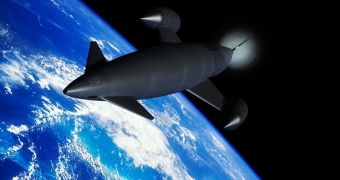Both the British National Space Center (BNSC) and the European Space Authority recently gave their seal of approval for engineers working to develop the Skylon spacecraft. The project has spent the last three decades in development, but experts say that it may now finally be ready for the next step.
A prototype of the new spaceplane design is being constructed at Reaction Engines Ltd., in Oxfordshire, the United Kingdom. The thing that separates this spacecraft from any other is its take-off and landing abilities.
While Skylon can reach low-Earth orbit (LEO) just like the American-built space shuttles can, it does not need a rocket, external fuel tanks or boosters to do so. The aircraft can take off and land from normal runways, its designers say.
This unpiloted spacecraft is completely reusable and self-contained, and it can make its way to space autonomously. Its amazing capabilities eliminate the need for expensive spaceports or launch pads to be built to accommodate its demands.
One of the things that allow Skylon to do this is its design, which features dual-stage propulsion. While still in the atmosphere, the aircraft flies like a normal airplane, but beyond a certain altitude, it behaves like a rocket.
This is made possible by the fact that the first stage of its flight is powered by liquid hydrogen fuel. When combined with atmospheric oxygen, this chemical creates a tremendously strong reaction.
After the spaceplane exceeds Mach 5 and an altitude of 26 kilometers, the conventional engines are shut down, and the rocket boosters set in, carrying Skylon on the final leg of its journey to orbit.
The hybrid SABRE engines that Skylon has allow the aircraft to carry up to 15 tons of cargo to LEO. The payload bay can hold satellites, scientific experiments and other equipment.
Reaction Engines official say that it's even possible to convert the cargo bay into a manned capsule, allowing passengers to travel to space for a price. The costs of doing so would be much lower than those associated with conventional rockets.
“No impediments or critical items have been identified for either the Skylon vehicle or the SABRE engine that are a block to further development,” the report of an European Space Authority panel states.
“The consensus for the way forward is to proceed with the innovative development of the engine which in turn will enable the overall vehicle development,” the document adds, as quoted by Universe Today.

 14 DAY TRIAL //
14 DAY TRIAL //